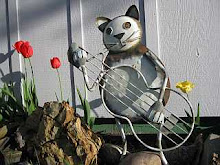I have finished the loading corral rebuild.
 It took me almost five years to completely rebuild the loading corral. I started in 2008 the year my mother was ill and passed away. The first year I rebuilt the outer south side. In 2010 I rebuilt the west and north sides. In 2011 I moved the head gate and rebuilt the east side. Now this year I finished the rebuild. I had six railroad ties left to replace and a newer gate to hang. As you can see I didn't work on the corral fence every year.
It took me almost five years to completely rebuild the loading corral. I started in 2008 the year my mother was ill and passed away. The first year I rebuilt the outer south side. In 2010 I rebuilt the west and north sides. In 2011 I moved the head gate and rebuilt the east side. Now this year I finished the rebuild. I had six railroad ties left to replace and a newer gate to hang. As you can see I didn't work on the corral fence every year.Here is a photo from when I started in 2008. The rope was to hold the two sides up when the cattle squeezed through this area.
Standing on the head gate, here is a view after I finished the south (left) side fence.
Here is the view when I started working again in April 2013. Before, and when I was done. The boards on top of some of the railroad ties are to hold the ties in place. The first tie on the right was placed in 2011 when I moved the head gate. In the two years since then I found the tie was now leaning out. The cattle squeezing through pushed the tie out a bit. The first order was to straighten the tie. Then, where I could, I added boards to hold the ties in place.
Before... and... after.
A slight bend in the path keeps the cattle from completely seeing all the way down the path to the stock trailer. I wish I had a little more of a bend as the bend does helps keep the cattle from baulking at moving down the path.
The holes for the railroad ties are a little bit bigger than usual. I dug the holes 30 inches deep. Usually there was dirt for the first 24 inches and then gravel and rocks the last 6 inches. One hole was 18 inches dirt and 12 inches gravel and rocks. Ugh.
Here are the rocks left over from several holes.
I added a small gate part way down the runway. In the past cattle would turn around and run back to the end. This mid point gate will stop that.
Some of the fence boards are 8 ft long and others are 16 ft long. Tammy helped me with the 16 ft boards as it is difficult to level, hold and nail 16 ft boards by myself.
The long view.
While the other railroad ties are mostly 10+ ft long with a few 12 ft and 14 ft ties, the last six ties are 8 1/2 to 9 ft long as I am about out of 10 ft ties. These are solid and heavy ties. I started this project with my sore shoulder, but even without the sore shoulder (which cleared up over the days as I worked), the ties took a lot of effort to move and lift into the holes. I think I am getting older.
I also replaced the gate.
 |
| The old gate |
 |
| The new gate |
I also reduced the size of the runway. The left posts show the original runway size. Over the years I found it to be a problem when the cattle were side by side trying to squeeze through the head gate. I made the first three ties from the head gate the narrow size of the head gate. That is - only one cattle could fit in that part of the runway. Then I flared the runway out. The old runway had too much room for loading a trailer load of cattle. That extra room allowed the cattle to turn around and go to the back of the runway. Sometimes we went in circles a number of times before I got the cattle to move down the runway. This is not something I wanted to do for time reasons and safety reasons.
To hang the gate I had to drill holes in the railroad tie for the gate's bolts. Of course the cattle were curious about the electrical cord.
When it came time to roll up the electrical cord I found one of the cattle left a calling card.
So now I have a good solid sturdy loading corral that should last me a long time. It has come a long way from the weak patched rundown corral I inherited from my father.
The cattle chewed their cud while I worked on the loading corral fence. The video is 33 seconds long.
https://www.youtube.com/watch?v=r8DPzORJIRo

























No comments:
Post a Comment